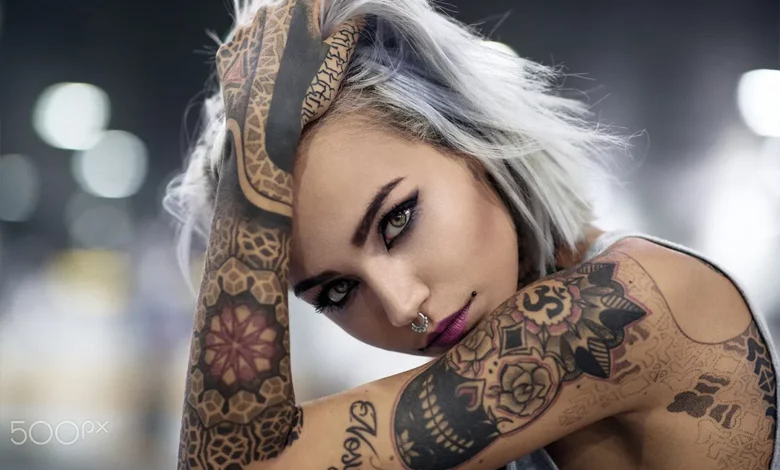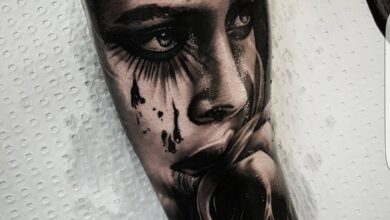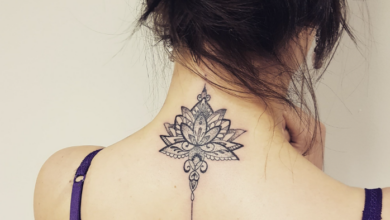
Get ready to immerse yourself in a world of dark elegance and moody beauty as we showcase an array of Gothic glamour tattoos. These mesmerizing ink creations capture the essence of darkness and evoke a sense of mystery and allure. From intricate lace designs to hauntingly beautiful portraits, these tattoos are a bewitching blend of artistry and symbolism. Step into this captivating realm and discover the enchanting world of Gothic glamour tattoos.

The Evolution of Gothic Tattoos
Historical roots of gothic tattoos
Gothic tattoos have a rich and intriguing history that dates back centuries. The origins of gothic tattoos can be traced back to various cultures and time periods, each contributing to the unique style and symbolism associated with this art form. One of the earliest influences on gothic tattoos comes from ancient Celtic and Norse cultures, where warriors adorned their bodies with intricate patterns and symbols to display their bravery and allegiance to their clans. These early tattoos often featured knotwork designs and animal motifs, representing themes of strength, protection, and spirituality.
As history progressed, the gothic style emerged during the Middle Ages, influenced by the Gothic architectural movement. This period in history is associated with grand cathedrals, dramatic ornamentation, and a fascination with death and the macabre. These themes translated into gothic tattoos, with imagery often inspired by religious iconography, demons, angels, and fantastical creatures. It was during this time that the Gothic script, with its ornate and dramatic lettering, became popular for tattooing, adding a distinctive aesthetic to gothic tattoo art.
Modern influences on gothic tattoo art
Gothic tattoos have evolved and adapted over time, influenced by various cultural movements and subcultures. In the 20th century, gothic tattoos became associated with the punk and goth subcultures, reflecting a rebellious and nonconformist attitude. During this era, tattoo artists began incorporating more edgy and edgy elements into their designs, such as bats, skulls, and dark imagery associated with death and the occult.
In recent years, gothic tattoo art has experienced a resurgence in popularity, thanks in part to the influence of alternative fashion trends and the rise of social media. Artists and enthusiasts alike have embraced the gothic aesthetic, utilizing advancements in tattooing techniques and technology to create intricate and visually striking designs. Today, gothic tattoos can be found in a wide range of styles, from traditional blackwork to stunningly detailed portraits, reflecting the diverse tastes and preferences of those interested in this unique form of body art.

Symbolism in Gothic Tattoos
Common symbols and motifs in gothic tattoos
Gothic tattoos are often characterized by their use of dark, mysterious, and sometimes macabre imagery. Common symbols and motifs found in gothic tattoos include skulls, bats, ravens, roses, crosses, spiders, and other elements associated with death, magic, and the occult. These symbols hold deep meaning within the gothic subculture, representing themes of mortality, rebirth, and a fascination with the unknown. They serve as visual reminders of the transient nature of life and the power of embracing one’s darker side.
The meaning behind popular gothic tattoo designs
While the specific meaning behind gothic tattoo designs can vary depending on the individual and the context in which they are used, there are some commonly understood interpretations. Skulls, for example, are often seen as symbols of mortality and the impermanence of life. They can represent a celebration of life in the face of death or serve as a reminder to live each day to the fullest. Bats, on the other hand, are often associated with mystery and the night, symbolizing intuition, transformation, and rebirth.
Roses have long been a popular symbol in tattoo art, and in gothic tattoos, they can take on a darker meaning. While roses traditionally represent love and beauty, in a gothic context, they can signify the fleeting nature of beauty and the inevitability of decay. Crosses are another prevalent symbol in gothic tattoos, evoking religious and spiritual connotations. They can represent a connection to the divine, a personal belief system, or serve as a rebellious statement against traditional religious norms.

The Intricate Artistry of Gothic Tattoos
Detailed linework in gothic tattoo designs
One of the defining characteristics of gothic tattoos is their intricate linework. Tattoo artists who specialize in gothic designs often have a keen eye for detail and possess a mastery of fine lines and shading techniques. These artists carefully craft their designs, paying close attention to the placement and direction of each line to create visually captivating tattoos.
Gothic linework often features precise and delicate patterns, such as knotwork, lace-like designs, or ornate filigree. These intricate lines add depth and texture to the tattoo, enhancing the overall visual impact. They require a steady hand and a high level of skill to execute, making gothic tattoos a true testament to the artistry of tattooing.
The use of shadows and negative space in gothic tattoos
In addition to detailed linework, shadows and negative space play a crucial role in gothic tattoo art. These elements allow tattoo artists to create depth and dimension within their designs, adding a sense of realism and drama. Shadows can be used to enhance the three-dimensional effect of a tattoo, making certain elements appear raised or recessed.
Negative space, on the other hand, refers to the areas of skin intentionally left uninked within a tattoo design. Tattoo artists strategically utilize negative space to create contrast, drawing attention to specific elements of the tattoo. This technique can be particularly effective when used to highlight lighter or more intricate sections of a gothic tattoo. By carefully balancing shadows and negative space, tattoo artists are able to bring their designs to life and create visually captivating works of art on the human canvas.

Gothic Tattoo Themes: From Graveyards to Victorian Elegance
Depictions of macabre and dark elements in gothic tattoos
Gothic tattoos often incorporate macabre and dark elements as a way to embrace the shadows and explore themes of mortality, darkness, and the supernatural. These tattoos can feature imagery related to death, such as gravestones, skeletons, or coffins, evoking a sense of mystery and intrigue. Some gothic tattoos may also include depictions of mythical creatures like vampires or werewolves, adding an air of fantasy and otherworldliness to the design.
The use of macabre elements in gothic tattoos allows individuals to explore their fascination with the darker aspects of life and confront their own mortality. It serves as a reminder of the fleeting nature of existence and can be seen as a celebration of the beauty found within darkness.
Incorporating Victorian aesthetics into gothic tattoo designs
Victorian aesthetics have had a profound influence on gothic tattoo art, providing a source of inspiration for many designs. The Victorian era was characterized by a fascination with death, mourning rituals, and a highly ornate and romanticized visual style. These themes have translated into gothic tattoos, with artists drawing inspiration from Victorian fashion, architecture, and symbolism.
Tattoos featuring elements such as lacework, cameos, corsets, or Victorian hairstyles and accessories reflect the elegance and opulence associated with this era. These designs often employ intricate linework and delicate shading techniques to capture the intricacies of Victorian aesthetics, giving the tattoos a timeless and sophisticated quality.
Popular Gothic Tattoo Styles and Techniques
Blackwork tattoos and their significance in gothic art
Blackwork tattoos are a popular choice within the gothic tattoo community, known for their bold and striking appearance. Blackwork tattoos utilize only black ink to create intricate designs, often featuring patterns, mandalas, or geometric shapes. The use of black ink allows for high contrast and creates a visually impactful tattoo that stands out on the skin.
Blackwork tattoos hold significance within gothic art as they align with the theme of embracing darkness. The boldness of these tattoos represents an individual’s willingness to delve into the depths of their own psyche and explore the shadows within themselves. The simplicity and starkness of blackwork tattoos make them a powerful form of self-expression within the gothic community.
Dotwork and stippling techniques in gothic tattoos
Dotwork and stippling techniques are commonly employed in gothic tattoos, adding depth, texture, and intricacy to the designs. These techniques involve using a series of dots or small, concentrated dots to create shading and highlights within the tattoo. By varying the density and size of the dots, tattoo artists can achieve a wide range of effects and create visually stunning pieces of art.
Dotwork and stippling techniques perfectly complement gothic tattoo designs by accentuating the detailed linework and bringing out the shadows and negative space. These techniques add a sense of mystery and depth to the tattoos, giving them a unique and captivating appearance.

The Appeal of Gothic Tattoos: Embracing the Dark Side
Psychological motivations behind choosing gothic tattoos
Choosing to get a gothic tattoo is often a deeply personal decision influenced by various psychological motivations. For some individuals, gothic tattoos can serve as a means of self-expression, allowing them to embrace their darker interests, emotions, or personal struggles. These tattoos can act as a form of catharsis, providing an outlet for individuals to explore and process complex emotions or experiences.
Gothic tattoos can also be a way for individuals to reclaim their own narrative and challenge societal expectations. By deliberately choosing to adorn their bodies with gothic imagery, individuals can break free from societal norms and express themselves authentically. For many, gothic tattoos serve as a form of empowerment, a visual representation of their individuality, and a rejection of the status quo.
How gothic tattoos can empower and express one’s individuality
Gothic tattoos have the power to empower individuals by allowing them to embrace their unique identities and interests. These tattoos act as a visual statement, defying societal expectations and celebrating one’s individuality. They can serve as a constant reminder of inner strength and resilience, empowering individuals to embrace their own darkness and use it as a source of power.
Gothic tattoos also provide a sense of community and belonging within the gothic subculture. By sporting gothic tattoos, individuals can connect with like-minded individuals and form meaningful connections. These tattoos act as a visual language, signaling shared interests and experiences, and creating a sense of camaraderie among those who appreciate the gothic aesthetic.
The Role of Color in Gothic Tattoos
The contrast between dark and vibrant colors in gothic tattoos
While gothic tattoos are often associated with dark and monochromatic colors, the use of color can play a significant role in enhancing the overall impact of these tattoos. Contrasting dark, muted tones with vibrant pops of color can create a visually stunning and dynamic tattoo.
The contrast between dark and vibrant colors in gothic tattoos can symbolize the duality of life – the interplay between light and darkness, beauty and decay. By incorporating vibrant colors, such as deep reds, electric purples, or vibrant greens, tattoo artists can add a sense of energy and vitality to their designs. These bursts of color can illuminate certain elements of the tattoo, drawing attention to specific symbols or motifs and adding a layer of depth and complexity to the overall composition.
The symbolic use of color in gothic tattoo art
In gothic tattoo art, colors are often chosen for their symbolic meaning, adding another layer of depth to the overall design. While black is the dominant color in gothic tattoos, it represents themes of mystery, elegance, and the unknown. Red, on the other hand, is often associated with passion, desire, and blood, emphasizing the visceral and intense nature of gothic imagery.
Purple is another color commonly used in gothic tattoos, symbolizing spirituality, mystery, and magic. By incorporating different colors strategically, tattoo artists can create a visual narrative within the tattoo, adding additional layers of symbolism and allowing the individual to communicate a particular message or theme through their body art.

Gothic Tattoos and Pop Culture
Gothic tattoos in film, television, and literature
Gothic tattoos have made appearances in various forms of popular culture, illustrating their enduring influence and appeal. In films and television shows, gothic tattoos are often used to visually convey a character’s dark or mysterious nature. These tattoos can serve as symbols of strength, rebellion, or affiliation with the supernatural world. Actors such as Johnny Depp, Kat Von D, and Angelina Jolie have portrayed characters with gothic tattoos, contributing to their popularity and cultural significance.
Literature has also played a significant role in shaping the perception and aesthetic of gothic tattoos. Works such as Bram Stoker’s “Dracula” and Mary Shelley’s “Frankenstein” have inspired a plethora of gothic tattoo designs, with artists drawing on the rich imagery and themes found within these classic works. The influence of gothic literature can be seen in tattoos featuring vampires, monsters, and other supernatural elements, evoking a sense of darkness and intrigue.
Influential figures and celebrities with gothic tattoos
Gothic tattoos have attracted the attention of numerous influential figures and celebrities, further establishing their place within popular culture. Musicians such as Marilyn Manson, Billie Eilish, and Gerard Way have embraced the gothic aesthetic, often showcasing their tattoos as part of their performance personas. These artists use their body art as a means of self-expression, aligning themselves with the gothic subculture and its themes of darkness, individuality, and nonconformity.
In the world of fashion, models and influencers such as Rick Genest, known as “Zombie Boy,” have gained fame for their intricate gothic tattoos. Zombie Boy’s intricate skeletal tattoos served as a transformative and powerful representation of his personal journey and brought attention to the artistry and creativity behind gothic tattoos.
The Dark Side of Tattooing: Controversies and Stigmas
Gothic tattoos and misconceptions about their meanings
Gothic tattoos, like any form of body art, are subject to misconceptions and misunderstandings. Due to their association with darker themes, gothic tattoos are sometimes mistakenly viewed as a sign of deviance or a reflection of criminal behavior. This misconception can lead to negative stereotypes and judgments about individuals with gothic tattoos, perpetuating stigmas and discrimination.
It is important to recognize that gothic tattoos, like all tattoos, are deeply personal and have varying meanings to the individuals who wear them. While gothic tattoos may incorporate dark imagery or symbols associated with death and the occult, they often serve as a form of self-expression, empowerment, or an appreciation for the aesthetic and cultural influences behind this art form.
Challenges faced by individuals with gothic tattoos in society
Those with gothic tattoos may face unique challenges and prejudices in society due to the perceived association between their tattoos and alternative subcultures. Individuals with gothic tattoos can be subjected to judgment, discrimination, or even denial of employment opportunities based on societal biases. These challenges highlight the importance of promoting acceptance and understanding of various forms of self-expression, including gothic tattoos.
Promoting education and awareness about gothic tattoos can help dispel misconceptions and encourage a more inclusive and accepting society. It is essential to recognize the individuality and diversity within the gothic community and to celebrate the artistry and creativity that gothic tattoos represent.

Caring for Gothic Tattoos: Maintenance and Aftercare
Special considerations for healing gothic tattoos
Proper aftercare is essential for ensuring the longevity and vibrancy of gothic tattoos. As with any tattoo, it is crucial to follow the artist’s aftercare instructions to facilitate the healing process. However, gothic tattoos often feature intricate linework and shading, which may require additional care and attention.
During the healing process, it is essential to keep the tattoo clean and moisturized to promote proper healing and reduce the risk of infection. Using a fragrance-free and gentle cleanser, individuals should gently wash the tattoo with clean hands, avoiding excessive rubbing or scrubbing. After washing, applying a thin layer of a tattoo-specific moisturizer can help keep the skin hydrated and prevent excessive drying, which could impact the overall quality of the tattoo.
Tips for preserving the integrity of gothic tattoo designs
To preserve the integrity of gothic tattoo designs, individuals can take certain steps to ensure their tattoos remain vibrant and visually striking for years to come. Avoiding excessive exposure to sunlight is crucial, as UV rays can cause fading and damage to the tattoo. Applying a broad-spectrum sunscreen with a high SPF to the tattooed area, especially when spending time outdoors, can help protect the tattoo from sun damage.
Maintaining a healthy lifestyle, including staying hydrated, eating a balanced diet, and avoiding excessive alcohol consumption, can also contribute to the longevity and vibrancy of gothic tattoos. Proper skincare, including regular moisturizing and exfoliating, can help keep the surrounding skin healthy and prevent any dryness or irritation that could impact the appearance of the tattoo.
By taking these steps and following proper aftercare, individuals can ensure that their gothic tattoos continue to be a source of pride and self-expression for years to come.
In conclusion, gothic tattoos have a fascinating history rooted in ancient cultures and influenced by various artistic movements and subcultures. They are defined by their dark and mysterious imagery, intricate linework, and symbolism. Gothic tattoos empower individuals to embrace their darker interests and express their individuality while challenging societal norms. With careful maintenance and proper aftercare, gothic tattoos can remain vibrant and visually captivating for a lifetime, serving as a constant reminder of the beauty found within darkness. Whether influenced by literature, film, or personal experiences, gothic tattoos continue to captivate and inspire individuals, proving that the allure of the dark side is a timeless and enduring form of self-expression.




